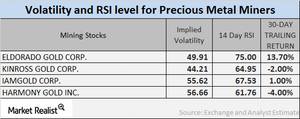Understanding Mining Stock Volatility in March
Now that mining companies have begun witnessing revivals from their losses earlier this year, it becomes crucial to examine the volatility figures and RSI.
March 31 2017, Updated 2:06 p.m. ET

Precious metal funds
Now that mining companies have begun witnessing revivals from their losses earlier this year, it becomes crucial to examine the volatility figures and RSI (relative strength index) levels of the individual stocks, as these also impact the investor’s buying process. In particular, investors should watch RSI levels in the wake of changing precious metal prices.
Leveraged mining funds such as the Direxion Daily Gold Miners (NUGT) and Proshares Ultra Silver (AGQ) rose substantially at the beginning of 2017 due to the revival among precious metals at that time. These funds rose 20.2% and 28.9%, respectively, on a YTD (year-to-date) basis.
Implied volatility
Call-implied volatility takes into account the changes in an asset’s price due to variations in the price of its call option. During times of global and economic turbulence, volatility is higher than in a stagnant economy.
As of March 28, the volatilities of Agnico-Eagle Mines (AEM), Primero Mining (PPP), Silver Wheaton (SLW), and Franco-Nevada (FNV) were 34.9%, 90.6%, 33.1%, and 31.2%, respectively. Remember, mining company volatility is often higher than precious metal volatility.
RSI levels
A 14-day RSI above 70 indicates the possibility of a downward movement in a stock’s price. A level below 30 shows the possibility of an upward movement in a stock’s price.
The RSI levels of the four mining giants mentioned above have risen due to higher stock prices. Agnico Eagle, Primero, Silver Wheaton, and Franco-Nevada had RSI levels of 64.2, 54.7, 64.2, and 67.1, respectively. And with the rise in the prices of these mining shares, the RSI levels of the stocks have increased.
